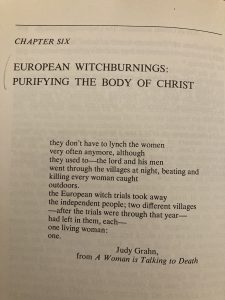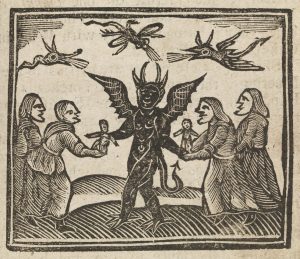The historical inception of the patriarchy as we know it today can be dated back thousands of years ago with the nascent of Abrahamic religion and the consequent oppression of pagan religions, which were notably matriarchal paradigms of the belief that revolved around nature goddess worship. As far back as antiquity as western religion can be traced, the supreme deity was female. The Great Goddess was not only an earth mother or an extension of a male god, she was the Source of life itself. The new male ruling class ushered in the patriarchal revolution, imposing a patrilineal kinship system that sanctified the oppression of women (Eller 285). It is of no surprise that the second version of the creation myth presents the creator as an omnipotent male deity, creating a male human being, from whose ribcage a woman is “born”, although every man is born from a woman’s womb. The creationist myth achieves the mythical transference of the power of creation and fertility from Goddess to God and from woman to man. The woman’s “original sin” is also held culpable for man’s fall from morality, thus justifying his dominion over her inherent sinfulness. Thus, the dichotomy of the gender binary was solidified– there was the male divine creator (spirit) and female natural creation (body) wherein other dichotomies were characterized as masculine/feminine (superior/inferior).

An excerpt from Judy Grahn’s poem “A Woman is Talking to Death” published in Gyn/Ecology: The Metaethics of Radical Feminism in 1978.
First published in the second issue of the lesbian radical feminist periodical Amazon Quarterly, in the epic nine-part poem “A Woman is Talking to Death,” Judy Grahn implicitly elucidates how the gynocide of women was a result of their association with nature. The narrator parallels the endemic lynching of African-Americans in the United States to one of the most notorious manifestations of the subjugation of female power, the witch hunts of medieval Europe, which were carried over with the pilgrimage of the Puritans. Indeed, the white patriarchs are no longer “[lynching] the women anymore” because they found a new class of people to subordinate (8). There is a long history of women holding positions of power or of stepping out of the boundaries imposed by patriarchal norms being discredited and persecuted that is evident throughout the pages of European history, and which formed the blueprint for the genocide of Native Americans and the ecocide of their lands during the colonization of the Americas. Threatened by the power women healers possessed with their knowledge of herbal remedies, the sons of the church “had to erase women with the power to heal, not only by killing them, but by denying that they healed of their own power,” attributing their healing powers instead to devil worship (Daly 218). Nonetheless, most of the women burned at the stake were not practitioners of witchcraft, but merely the victims of the patriarchs’, “the lord and his men,” paranoid obsession with “independent people,” as women are deemed to be “witches” for defying gender norms imposed by Judeo-Christian doctrines (8-9). According to Mary Daly, a prominent feminist scholar of religion, the sole intent of the witchunt was “to break down and destroy strong women, to dis-member and kill the Goddess, the divine spark of be-ing in women” (183). The poet then anthropomorphizes Death as the patriarchy itself. The abstract entity of “Death” is literally given he/him pronouns and is manifested in domestic violence, as exemplified by “death [sitting] in her bedroom, loading / his revolver”), presumably to murder his wife and the mother of his “6 young children” (8), the modern incarnation of the mass genocide of women in the name of Christendom during the European Crusade. Because of the creationist myth perpetuated by the Bible, the woman’s original sin, attributed to her “carnal, bodily desire,” is held culpable for man’s fall from morality, thus justifying his dominion over her inherent sinfulness (Daly 180).

Woodcut depicting witches giving offerings to the Devil.
Grahn implicitly articulates how the root of patriarchal oppression is the dichotomy that fragments reality into the male/female duality, with the former oppressing the latter. This results in not only the patriarchal subjugation of females, but to conflicts and wars between nations, to racism and the colonization of civilizations deemed as inferior, and the exploitation of the environment by humankind who seeks to dominate the untamed wilderness. The patriarchy is the “father” of oppression experienced by humanity and nature and has historically been constructed on the foundation and learned from the exploitation of women. This idea is echoed by “Toward a Woman Vision,” a critical essay purposefully situated right after Grahn’s poem. In this essay, the editor, Laurel, emphasizes that the women’s liberation movement and ecological concern are “inextricably linked”– the only solution to end the “rape of [our] sister earth” is to shatter the male mirror and to resurrect a “womanvision” (33). Just like how Grahn personifies patriarchal capitalist society as the character of “Death,” Laurel compares the exploitation of the source of life itself, the earth, to the sexual terrorism inflicted upon the givers of life, women. Until the male culture of rapism is transformed into a culture of reciprocity, life as we know it, Laurel warns, will be bled out of existence and into extinction, just like women have for millenia.
Sources:
Amazon Quarterly, vol. 2, no. 2, December 1973.
Daly, Mary. Gyn/Ecology: The Metaethics of Radical Feminism. Beacon Press, 1978.
Eller, Cynthia. “Relativizing the Patriarchy: The Sacred History of the Feminist Spirituality Movement.” History of Religions, vol. 30, no. 3, University of Chicago Press, 1991, pp. 279–95, http://www.jstor.org/stable/1062958. Accessed 6 December 2021.
Grahn, Judy. “A Woman is Talking to Death.” Amazon Quarterly, vol. 2, no. 2, pp. 4-17.
Laurel. “Toward A Womanvision.” Amazon Quarterly, vol. 2, no. 2, pp. 18-42.
